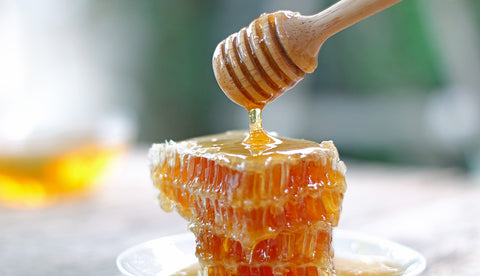Honey comes in a variety of types, each with unique flavors, colors, and textures. The differences in honey are primarily due to the flowers visited by the bees that produce it. Here's a brief introduction to the different types of honey:
Here’s a deeper dive into each type of honey, including origin, benefits, and uses:
1. Clover Honey
• Origin: Primarily produced in the U.S., Canada, and New Zealand
• Health Benefits: Contains antioxidants, antibacterial properties, and may help soothe coughs
• Uses: Commonly used in baking, tea, salad dressings, and as a general sweetener
• Interesting Fact: One of the most widely available and commercially produced honeys
2. Manuka Honey
• Origin: New Zealand and Australia, from the nectar of the Manuka bush (Leptospermum scoparium)
• Health Benefits:
• High in methylglyoxal (MGO), giving it strong antibacterial properties
• Supports wound healing and gut health
• Helps with sore throats and colds
• Uses: Consumed raw for medicinal purposes, used in skincare, added to herbal teas
• Interesting Fact: Some Manuka honey is graded with a UMF (Unique Manuka Factor) rating that measures its potency
3. Acacia Honey
• Origin: Europe and North America, from the Black Locust tree (Robinia pseudoacacia)
• Health Benefits:
• High in fructose, making it less likely to crystallize
• Gentle on digestion and may help regulate blood sugar levels
• Contains antibacterial and anti-inflammatory properties
• Uses: Perfect for sweetening drinks, drizzling over fruit, and pairing with cheese
• Interesting Fact: One of the clearest honeys, almost water-like in appearance
4. Buckwheat Honey
• Origin: Produced in the U.S., Canada, and Eastern Europe
• Health Benefits:
• High in antioxidants, more than lighter honeys
• Excellent for soothing coughs and sore throats
• May help support immune function
• Uses: Commonly used in marinades, barbecue sauces, and natural cough syrups
• Interesting Fact: Its dark, molasses-like flavor makes it popular in beer brewing
5. Orange Blossom Honey
• Origin: Mainly from Florida, Texas, California, and Spain
• Health Benefits:
• Rich in vitamin C and antioxidants
• Helps with relaxation and stress relief
• Has mild antibacterial properties
• Uses: Great for drizzling over desserts, pairing with yogurt, or adding to herbal teas
• Interesting Fact: Despite its name, it can include nectar from other citrus trees like lemon and lime
6. Wildflower Honey
• Origin: Varies by region; made from multiple wildflowers blooming in a season
• Health Benefits:
• Contains a wide range of antioxidants
• Supports seasonal allergy relief (if locally sourced)
• Offers antibacterial and anti-inflammatory benefits
• Uses: Versatile for baking, smoothies, salad dressings, and spreading on toast
• Interesting Fact: Its flavor and color change based on the flowers used, making each batch unique
7. Eucalyptus Honey
• Origin: Australia, Spain, Portugal, and South America
• Health Benefits:
• Helps with respiratory issues like coughs, congestion, and sore throats
• Has natural antiseptic properties
• May aid in digestion
• Uses: Ideal for teas, herbal remedies, and adding to warm water with lemon
• Interesting Fact: Has a mild menthol-like aftertaste, making it great for medicinal use
8. Lavender Honey
• Origin: Primarily from France, Spain, and Italy
• Health Benefits:
• Helps with relaxation, stress reduction, and sleep
• Contains antibacterial properties
• May aid digestion and reduce inflammation
• Uses: Best for sweetening tea, drizzling over cheese, and baking
• Interesting Fact: Bees that pollinate lavender produce honey with a strong floral aroma and a slightly herbal taste
9. Heather Honey
• Origin: Mainly found in Scotland, Ireland, and parts of Europe
• Health Benefits:
• High in proteins compared to other honeys
• Rich in antioxidants and minerals
• Helps boost immune function
• Uses: Used in gourmet cooking, pairing with strong cheeses, and spreading on toast
• Interesting Fact: It has a thick, jelly-like texture rather than a runny consistency
10. Sidr Honey
• Origin: Yemen, Pakistan, and parts of the Middle East
• Health Benefits:
• Highly valued for medicinal properties
• Helps with digestive issues, wound healing, and boosting immunity
• Considered an aphrodisiac in traditional medicine
• Uses: Consumed raw, often taken in small amounts for health benefits
• Interesting Fact: One of the most expensive honeys in the world, prized for its purity and rarity




